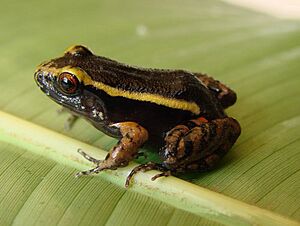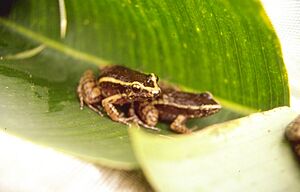Lithodytes facts for kids
Quick facts for kids Lithodytes |
|
|---|---|
 |
|
| Conservation status | |
| Scientific classification | |
| Synonyms | |
|
The gold-striped frog, also called the painted antnest frog, is a special type of frog found in tropical South America. Its scientific name is Lithodytes lineatus. This frog lives in warm, wet forests, often hiding among fallen leaves on the ground. It's the only species in its group, called Lithodytes.
These amazing frogs build foamy nests near temporary puddles. Their baby frogs, called tadpoles, grow up inside these nests. What's even cooler is that these frogs sometimes live and even lay their eggs inside the nests of certain leafcutter ants, like Atta cephalotes, without the ants attacking them!
Contents
About the Gold-Striped Frog
The female gold-striped frog can grow to be about 3.8 to 5.2 centimeters (1.5 to 2 inches) long. Males are a little smaller. This frog has a slim body and a rounded snout. It is mostly black with two bright yellow stripes running along its sides, from its nose all the way to its back legs. Near its back legs, it has a bright red or orange spot. Its legs are brown with black bands.
This frog looks a lot like some other frogs that are poisonous, such as the brilliant-thighed poison frog (Allobates femoralis) and the Amazonian poison-dart frog (Ameerega picta). By looking like these dangerous frogs, the gold-striped frog tricks predators into thinking it's also poisonous, which helps it stay safe. This is called mimicry.
Life Cycle and Tadpoles
The tadpoles of the gold-striped frog are a bright pink color, which gets lighter near their tails. They have clear pink fins and dark eyes. A clear white stripe runs down the middle of their backs. These tadpoles often swim together in tight groups. They move their tails up and down quickly to swim forward.
Where Gold-Striped Frogs Live
The gold-striped frog lives in many parts of tropical South America. You can find it in places like Colombia, Venezuela, Ecuador, Peru, Bolivia, Brazil, and the Guianas. It lives in warm, wet lowland forests, moist savannas, and temporary freshwater marshes. These frogs can be found from sea level up to about 1,800 meters (5,900 feet) high. They like to hide under logs, in leaf litter, and in other secret spots on the forest floor.
Conservation Status
This frog species is very common and lives in a wide area. Scientists believe there are many gold-striped frogs in total. While their numbers might be going down a little because their habitat is sometimes damaged, these frogs can often live in new or changed environments. They also live in many protected areas. Because of this, the International Union for Conservation of Nature (IUCN) says the gold-striped frog is a species of "least concern". This means they are not currently at risk of disappearing.
Amazing Ant Friends
The gold-striped frog is often found living near leaf-cutter ants, especially Atta cephalotes. Male gold-striped frogs have been seen calling out for mates from inside active ant nests, and the ants don't seem to hurt them! Normally, these ants would kill any animal that tries to enter their nest.
Scientists think that the frogs have a special smell that tells the ants not to attack them. In one case, four male frogs were calling together from inside a large ant nest. They made short whistling sounds very quickly. Another ant nest was found to have tunnels leading down to water, with foamy frog nests attached to roots in the tunnel walls. Tadpoles were swimming in the underground water, and ants were also moving through these tunnels.
Why Frogs and Ants Team Up
The frogs get a lot of benefits from living with the ants. Their breeding spots are very safe from predators like spiders, beetles, wasps, snakes, and turtles, which often eat frog eggs on land. Also, ant nests have a steady, humid environment, which is perfect for frog eggs to grow. The foam nests help keep the eggs warm and moist.
It's not clear if the ants benefit from this friendship. Scientists have looked at what the frogs eat and found they mostly eat earthworms, crickets, and other insects, with less than 10% being ants. Maybe the frogs help the ants by eating other insects that compete with or prey on the ants. Leaf-cutter ants mainly eat fungus that they grow in their nests, so they don't need to eat other prey. This means the frogs don't eat the ants' food.
Frogs have also been seen calling from inside Atta laevigata nests, and young frogs have been seen coming out of Atta sexdens nests.
Reproduction and Parental Care
The gold-striped frog builds special foam nests. While we don't know exactly how Lithodytes lineatus makes its foam nests, other frogs in the same family build them in similar ways. Usually, the male and female frog mate, and the female releases fertilized eggs and a jelly-like substance. The male then moves his legs like windshield wipers, mixing air into the jelly to create foam around the eggs. This whole process happens very quickly.
These foam nests are often found in dry or changing environments where temperatures can be high and water levels can change. The foam helps protect the eggs from drying out, which would be very bad for them. Foam nests also create a warm and moist place, helping the eggs and tadpoles grow quickly. The female frog often stays in the middle of the foam nest to guard her eggs from predators.
The foamy texture of the nest also helps keep many predators away. Snakes find it hard to swallow the nest, and insects like ants, wasps, and beetles often get stuck in the foam and die.
Social Behavior
Mating Calls and Competition
Male gold-striped frogs often face each other when calling for mates, with their snouts almost touching. They can stay in this position for many nights in a row. These males call very quickly, making a two-note sound that alternates between them. This strong calling behavior shows how much they compete for mates. They continue this behavior even when humans are watching them closely with flashlights.
Gold-striped frogs usually breed during the rainy season. This is when pregnant females and calling males are most common, and young frogs are seen more towards the end of the season. This is because frog babies need standing water to grow. Also, bigger female frogs lay more eggs than smaller ones. Mating adult frogs are most often found on the forest floor, calling near Atta ant nests. Large ant nests often have several frogs calling from them.
How Frogs Defend Themselves
When threatened, the gold-striped frog uses a defense strategy called deimatic behavior. It lowers its head and lifts its back end by stretching its legs straight up. This position protects its head and shows off the bright, warning colors (yellow stripes and orange spots) on its inner thighs to potential predators. The frog also closes its eyes with a special membrane for protection.
If a predator catches it, the frog makes short, high-pitched calls. When stressed, they also release a foamy, sticky liquid from their skin that has a strong bitter smell.
Scientists have found that the gold-striped frog's ability to live safely in leaf-cutting ant nests is linked to special chemicals on its skin. These chemicals create a distinct smell that prevents the ants from attacking. Other frogs that are closely related to Lithodytes lineatus are attacked by leafcutter ants, but Lithodytes lineatus frogs are not affected. When other frogs are coated with skin extracts from Lithodytes lineatus, they are also protected from ant attacks. Both male and female frogs seem to produce these protective chemicals.
This special defense isn't only found in Lithodytes lineatus. Similar observations have been made with other frogs and ants. Researchers think these chemicals might act as "appeasement allomones," which means they help calm down insect aggression. This could even have uses in reducing insect aggression in other areas.
Hunting Habits
Adult gold-striped frogs usually hunt for food at night. They are sometimes found away from their hiding spots, typically when they are looking for something to eat.
Mimicry and Protection
Looking Like Poisonous Frogs
For a long time, scientists thought the gold-striped frog was not poisonous. Its similar look to the poisonous dart frog Ameerega picta made people think it was a case of Batesian mimicry. This is when a harmless animal looks like a harmful one to avoid predators.
However, recent studies of the gold-striped frog's skin and poison glands have shown that it does have some proteins and chemicals that might be toxic. The poison glands of Lithodytes lineatus are mostly found on its head and in its colored stripes and spots. This is different from most frogs, where poison glands are spread out evenly. This special placement of glands on the colored parts might tell predators that the poison is right there. Having many glands on the head might be because predators often start eating frogs from the head.
Because Lithodytes lineatus might actually be a little poisonous, its relationship with Ameerega picta could be a case of Müllerian mimicry. This is when two or more harmful species share similar warning colors. Predators learn to avoid these shared patterns, which benefits all the species involved.



